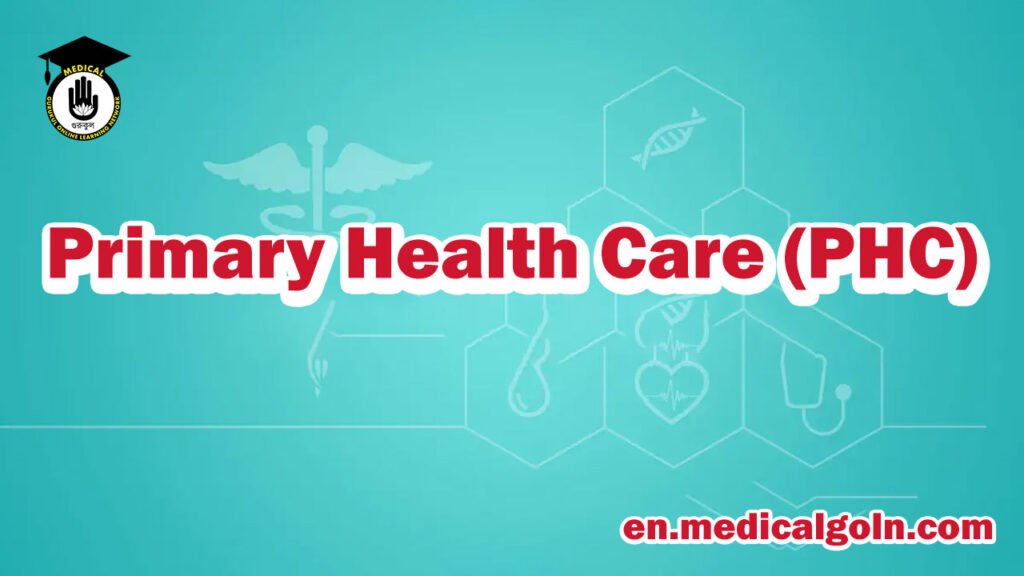Today is our topic of discussion Primary Health Care (PHC)
Primary Health Care (PHC)
History:
Primary health care (PHC) is a new approach to health care, which integrates at the community level with the aim of providing access to health care to all individual. The definition of PHC was evolved in 1978 following an international conference in Alma-Ata. in the formerly USSR.
Definition:
Essential health care based on practical, scientifically sound and socially acceptable methods and technology made universally accessible to individuals and families in the community through their full participation and at a cost that the community and the country can afford to maintain at every stage of their development in the spirit of self-reliance and self-determination.
Principles of primary health care:
- Equitable distribution
- Community participation
- Intersectoral collaboration
- Appropriate technology
Equitable distribution:
Health services must be shared equally by all people, irrespective of their ability to pay and all (rich or poor, urban or rural) must have access to the health services. At present, health services are mainly concentrated in the major towns and cities resulting in unequal distribution of health care to the people, particularly in rural areas.
Community participation:
The universal coverage by primary health care cannot be achieved without the involvement of the local community. There must be a continuing effort to ensure meaningful involvement of the community in the planning, implementation and maintenance of health services through maximum reliance on local resources in terms of manpower, money and materials.
Intersectoral collaboration:
The Declaration of Alma-Ata states that the ‘primary health care involves in addition to health sectors, all related sectors and aspects of national and community development, in particular, agriculture, animal husbandry, food, industry, education, housing, public works, communication and other sectors’.
Appropriate technology:
It means that the technology which is to be adopted for PHC should be scientifically sound, socially acceptable, adaptable to local needs and the peoples should have the capability to maintain the same by the existing resources.
Example – preparation of home-made oral rehydration saline, formation of Trained Birth Attendants (TBA’s) from the community with the aim of safe delivery etc.
Goal of PHC:
- The global goal as stated in the Alma Ata Declaration is Health for All by the year 2000 through self-reliance.
- Health begins at home, in schools and in the workplace because it is there where people live and work that health is made or broken.
- It aims that people will use better approaches than they do now for preventing diseases and alleviating unavoidable disease and disability and have better ways of growing up, growing old and dying gracefully.
- There will be even distribution among the population of whatever resources for health are available.
- The ultimate goal is that, essential health services will be accessible to all individuals and families in an acceptable and affordable way.
Elements/components of primary health care:
The declaration of Alma-Ata (1978) stated that primary health care includes at least the following services –
- Education about prevailing health problems and methods of preventing and controlling them.
- Promotion food supply and proper nutrition.
- An adequate supply of safe water and basic sanitation. 4. Maternal and child health care including family planning & safe sex.
- Immunization against infectious diseases.
- Prevention and control of local diseases.
- Appropriate treatment of common diseases and injuries.
- Provision of essential drugs.
To le bon veg of Vilide [To memorize, remember the formula ELEMENTS]
E-Education for health
L-Local disease control
E-Expanded program for immunization
M-MCH care including responsible parenthood
E-Essential drugs
N-Nutrition
T-Treatment of communicable and non-communicable diseases
S-Safe water and sanitation
Accessory elements of PHC:
In addition to eight essential elements, PHC activities in Bangladesh cover the following –
- Prevention and management of non-communicable diseases (NCDs)
- Interventions relating to arsenicosis
- Environmental and occupational health 4. Health of the senior citizens, adolescents and young peoples
- Injury prevention and management and stritiv ginummos all mod) (A&T) ambas
- Violence against women
Strategies of PHC:
- Training/ retraining of staff on the elements and principles of PHC; 2. Provision of basic essential equipment; and
- Ensuring uninterrupted supply to facilitate effective preventive, curative, promotive and rehabilitative services to the vulnerable, the disadvantaged and the poor.
Implementation of PHC:
- National level: At national level, the Directorate of Primary Health Care and Line Director of ESP are responsible for the planning and implementation of PHC activities.
- District level: The Civil Surgeon and the District team provide technical and administrative support by periodic supervision to the UHFPO and team.
- Upazila level: It constitutes the first level of referral in the PHC System. Curative care is provided by specialists (obstetrics and gynaecology, medicine, surgery), medical officers. SACMOS and supportive laboratory and related personnel. Promotive and preventive services are supported by Health Inspectors, Sanitary Inspectors and Assistant Health Inspectors.
- Union and Ward levels: The UHFPO is the overall administrative and technical head of the Upazila Health Complex, as well as all health services up to the community level. The Union level facilities run by field level health and family welfare workers.
- Community Participation: Community participation being one of the pillars of PHC, established through Village Health Volunteers (VHVS) nominated by the community people and trained under the PHC intensification project
Comprehensive PHC:
Comprehensive PHC has been defined as the set of activities that –
- Contains a minimum of 8 core activities mentioned in the Alma Ata declaration.
- Ensures effective referral system among:
- Primary level
- Secondary level
- Tertiary level
- Considers principles of:
- Promotive, preventive, curative and rehabilitative services
- Equity
- Appropriate Technology
- Intersectoral Collaborations
- Community Participation
- Decentralization
Community Based Health Workforce in Bangladesh:
- Health assistants (HA)
- Assistant health inspectors (AHI)
- Skilled birth attendants (SBA)
- Family welfare visitors (FWV)
- Family welfare assistants (FWA)
- Village health volunteers (VHV)
See also :

